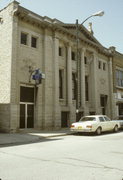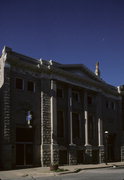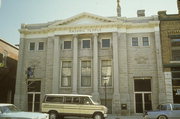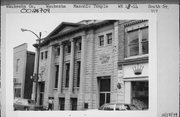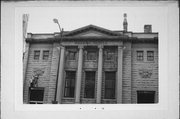Property Record
317 SOUTH ST
Architecture and History Inventory
| Historic Name: | Masonic Temple |
|---|---|
| Other Name: | |
| Contributing: | Yes |
| Reference Number: | 28709 |
| Location (Address): | 317 SOUTH ST |
|---|---|
| County: | Waukesha |
| City: | Waukesha |
| Township/Village: | |
| Unincorporated Community: | |
| Town: | |
| Range: | |
| Direction: | |
| Section: | |
| Quarter Section: | |
| Quarter/Quarter Section: |
| Year Built: | 1904 |
|---|---|
| Additions: | |
| Survey Date: | 1979 |
| Historic Use: | social recreational/fraternal hall |
| Architectural Style: | Neoclassical/Beaux Arts |
| Structural System: | |
| Wall Material: | Limestone |
| Architect: | A.l. Flegel |
| Other Buildings On Site: | |
| Demolished?: | No |
| Demolished Date: |
| National/State Register Listing Name: | Downtown Historic District |
|---|---|
| National Register Listing Date: | 10/28/1983 |
| State Register Listing Date: | 1/1/1989 |
| National Register Multiple Property Name: | Multiple Resources of Waukesha |
| Additional Information: | A 'site file' exists for this property. It contains additional information such as correspondence, newspaper clippings, or historical information. It is a public record and may be viewed in person at the Wisconsin Historical Society, State Historic Preservation Office. THE WAUKESHA BRANCH OF THE MASONIC LODGE WAS FOUNDED IN 1852 AND FOR MANY YEARS RENTED SPACE IN THE BARNES BLOCK ON MAIN ST. THE FIRST MEETING IN THE CURRENT BUILDING WAS HELD IN NOVEMBER 1904. The Masonic Temple is a nicely detailed Classical Revival building. The facade of the building is veneered with rock faced ashlar, regularly coursed. The smooth stone employed for the shafts of columns and pilasters contrast with the more textural wall surface. The two composite columns and pilasters are incorporated into an engaged portico which projects slightly from the central pavilion of the facade. The columns rise from the raised basement, two stories to the entablature. Overall, the Masonic Temple is a monumental building, composed of carefully crafted stone and high quality ornament. The local limestone (Niagara dolomite) dominated commercial construction during the ninetenth century in the downtown area of Waukesha. Comparison of the Masonic Temple with earlier commercial blocks (Concentrated on W. Main ST.) provides an interesting contrast in technique as well as taste. The Masonic Temple, architecturally significant as a representative example of a period of construction, is one of Waukesha's finest examples of Classical Revival design. A comparable building remaining in the city is the Post Office (235 W. Broadway WK 6/1). Other major buildings which were designed with reference to this style have been significantly altered: Public Library (321 Wisconsin Ave., WK 48/27), the National Exchange Bank (309-311 W. Main Street WK 6/29) and the Waukesha National Bank (831 N. Grand Ave., WK 50/28). This building has been home to the Masonic orders in Waukesha since its constructionin 1904. The Masonic Lodge was founded in 1852. It was housed in the Barnes Block at 329-333 W. Main from 1858 to 1882 and in the Putney Block at 301 W. Main from that time until the present building was completed. |
|---|---|
| Bibliographic References: | (A) Zimmerman, #770. (B) The Five Points Downtown Historic District Walking Tour, Waukesha Landmarks Commission. (C) Building inscription. (D) "All Masonic Bodies in Waukesha Work Together As One," Masonic Tidings, Nov., 1935. Waukesha Freeman, 5/12/1999. The Improvement Bulletin 4/9/1904. |
| Wisconsin Architecture and History Inventory, State Historic Preservation Office, Wisconsin Historical Society, Madison, Wisconsin |

